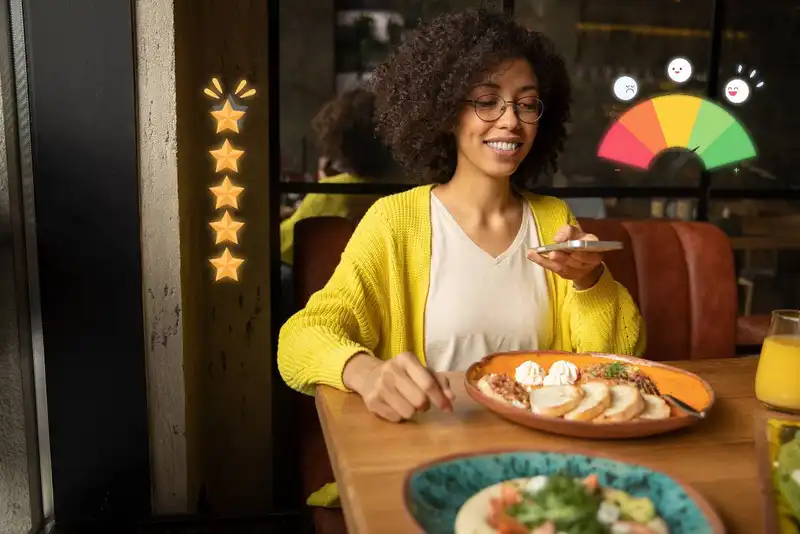What type of reviews work best for marketing?
The best reviews for marketing are recent, specific, and emotionally engaging, highlighting unique dishes, excellent service, or memorable experiences. They should use vivid, authentic language that reflects your brand's values and resonates with potential diners' expectations.
How to Leverage Restaurant Reviews in Your Marketing Campaigns
Why Reviews Are More Than Just Feedback
In today's dining landscape, a restaurant's online presence can be just as influential as its food. Customer reviews, often seen as simple feedback, have evolved into one of the most powerful marketing tools available. Studies show that most diners read reviews before deciding where to eat, and many trust these opinions as much as personal recommendations.
When leveraged correctly, reviews go beyond star ratings - they become authentic, persuasive endorsements that can influence potential customers more than polished ads ever could. By featuring real customer voices in your marketing, you showcase genuine experiences, build trust, and give potential diners a clear reason to choose your restaurant.
Understanding the Value of Customer Feedback in Marketing

Customer reviews are more than words on a screen - they're powerful decision-making triggers. In marketing terms, they serve as social proof, reassuring potential diners that others have had a positive experience and that your restaurant delivers on its promises. Research consistently shows that a significant percentage of customers are more likely to visit a business with positive reviews, and even a slight improvement in ratings can lead to noticeable increases in revenue.
For restaurant owners, the real value lies in how reviews shape perception. A professionally taken photo of your signature dish might catch someone's attention, but a heartfelt review describing how "the flavors reminded me of my grandmother's cooking" creates a stronger emotional pull. This emotional connection is often what drives people from curiosity to action.
Reviews also serve as unfiltered, customer-generated content - something that's increasingly trusted over traditional advertising. Unlike marketing copy you write yourself, customer feedback feels unbiased and authentic, which makes it more persuasive to new guests. When you feature these voices in your campaigns, you're essentially letting satisfied customers do the selling for you.
From a practical standpoint, feedback can guide your marketing focus. If multiple reviews praise a specific dish, you can spotlight it in ads, menus, and social media posts. If guests highlight fast, friendly service, that becomes a brand strength to promote.
Selecting the Right Reviews to Feature
Not all reviews are equally effective for marketing purposes. The goal is to select feedback that not only paints your restaurant in a positive light but also communicates specific, relatable details that potential diners will find meaningful. While a simple "Great food!" is nice to hear, it lacks the depth and uniqueness needed to stand out in a marketing campaign.
Start by looking for reviews that contain specific praise - mentions of signature dishes, standout drinks, unique ambiance, or exceptional service moments. Comments that paint a vivid picture help future guests imagine themselves enjoying the same experience. For example, "The grilled salmon was perfectly seasoned and paired beautifully with the citrus glaze" is far more engaging than a generic compliment.
Also, consider recency. Consumers are more influenced by fresh feedback because it reassures them that your quality is consistent. A glowing review from three years ago may not have the same impact as one from last week.
It's equally important to choose reviews that align with your brand values and target audience. If you're a fine-dining restaurant, reviews that highlight elegance, attention to detail, and atmosphere will reinforce your brand identity. If you're a casual, family-friendly spot, feedback emphasizing comfort, generous portions, and friendly staff will resonate more.
Lastly, maintain authenticity by keeping the customer's exact wording intact when featuring reviews. Polishing them too much can strip away the genuine tone that makes them powerful. By carefully curating which reviews you showcase, you ensure every featured quote strengthens your marketing message and helps attract the right type of customer to your restaurant.
Featuring Reviews in Social Media Posts
Social media offers one of the most effective ways to share customer reviews, allowing restaurant owners to amplify authentic feedback in a visual and engaging format. To maximize impact, focus on these four practical strategies -
1. Create Eye-Catching Quote Graphics
Select a short, impactful excerpt from a review and pair it with a high-quality photo of the dish or restaurant feature mentioned. Keep the reviewer's exact wording intact to maintain authenticity, and credit them appropriately (using first name or initials if privacy is a concern).
2. Use Carousel Posts and Stories
Carousel posts let you showcase multiple reviews in a single post - covering different aspects such as food, service, and atmosphere. Instagram or Facebook Stories are perfect for fresh, time-sensitive highlights, such as a great review from the previous night. Save these to a "Reviews" highlight so they remain accessible.
3. Incorporate Reviews into Video Content
Short videos can make testimonials even more engaging. Record staff reading reviews aloud, or overlay review text on footage of dishes being prepared or plated. This combines social proof with behind-the-scenes storytelling.
4. Engage and Encourage Interaction
Always respond to comments on review posts, publicly thank the reviewer, and invite others to share their own experiences. This builds community and encourages more user-generated content.
By using these approaches consistently, you transform customer reviews into an ongoing source of relatable, persuasive marketing content that strengthens your brand presence on social media.
Using Reviews in Digital and Print Advertising

Customer reviews can be powerful tools in both digital and print advertising, providing authentic voices that validate your restaurant's offerings. When incorporated thoughtfully, they help potential guests feel more confident choosing your establishment.
1. For digital ads on platforms like Facebook, Instagram, or Google, short, punchy review snippets work best. Focus on quotes that highlight unique selling points such as a popular dish, friendly service, or ambiance. Keep these snippets concise to fit within ad copy, and pair them with high-quality images or videos to catch attention. Including a star rating alongside the quote can also boost credibility and help your ad stand out in crowded feeds.
2. In print materials - such as flyers, posters, table tents, or mailers - reviews add a human touch that standard marketing messages often lack. Place brief customer quotes next to menu highlights or special offers. For example, a review praising your signature burger could appear right beside its description, reinforcing the appeal. When designing these materials, balance text and visuals carefully to avoid clutter while keeping the customer feedback prominent and easy to read.
3. It's important to maintain authenticity by using real reviews without heavy editing. Avoid overloading ads with too many quotes; instead, select the most relevant and compelling ones that directly support the message you want to convey.
Finally, test different quotes and formats to see which resonate best with your audience. Tracking ad performance through click-through rates, engagement, or reservations can help you refine your approach over time. By integrating customer reviews into both digital and print advertising, you leverage genuine experiences to build trust and attract more diners effectively.
Adding Reviews to Menus and In-Restaurant Materials
Incorporating customer reviews directly into your menus and other in-restaurant materials is a subtle but effective way to reinforce positive impressions at the moment diners make choices. When done thoughtfully, these testimonials can enhance the dining experience and encourage repeat visits.
Start by featuring short, specific reviews next to menu items they mention. For example, if several guests rave about your signature pasta dish, include a brief quote like, Best pasta I've ever had! right beside its listing. This not only highlights popular dishes but also guides new customers toward trusted favorites. Keep quotes concise to avoid overwhelming the menu layout.
Beyond menus, consider displaying reviews on table tents, chalkboards, or digital screens within the restaurant. These can spotlight recent feedback, special mentions, or seasonal favorites praised by guests. This creates a sense of community and shows diners that you value their opinions.
When integrating reviews into physical materials, it's essential to maintain a clean, balanced design. Too many quotes can clutter menus or distract from important information. Aim for a few well-chosen testimonials that complement your branding and overall aesthetic. Use fonts and colors consistent with your menu style to keep the look polished and professional.
Additionally, update these featured reviews regularly to reflect fresh experiences and maintain relevance. Outdated feedback may give the impression that you're not actively engaging with your customers.
By embedding customer praise within menus and in-restaurant displays, you turn honest feedback into an engaging, on-site marketing tool that supports ordering decisions, builds trust, and ultimately enhances the overall dining experience.
Tracking the Impact of Review-Based Marketing
To maximize the benefits of using customer reviews in your marketing, it's essential to track and analyze their impact. Here are four key steps to effectively measure your efforts -
1. Monitor Social Media Engagement
Track likes, shares, comments, and saves on posts featuring reviews. Higher engagement compared to other content indicates that your audience values authentic customer feedback.
2. Analyze Digital Ad Performance
Measure click-through rates (CTR) and conversion rates such as reservations or online orders from ads that include reviews. Comparing these metrics with ads without testimonials shows how persuasive reviews are in driving action.
3. Observe In-Restaurant Sales Trends
Pay attention to any increase in orders for menu items promoted with customer quotes. This can signal that reviews are influencing diner choices and boosting sales of featured dishes.
4. Use Analytics Tools
Leverage tools like Google Analytics and social media insights to gather detailed data on website visits, post reach, and audience behavior. Regular analysis helps identify what works and where adjustments are needed.
By following these steps, you can continuously refine your review-based marketing strategy, focusing on the content and formats that deliver the best results. Tracking not only helps justify your marketing efforts but also ensures that customer feedback continues to drive growth and engagement for your restaurant.
Keeping the Cycle of Feedback and Marketing Alive
Leveraging customer reviews in your marketing campaigns isn't a one-time effort - it's an ongoing process that requires consistent attention and adaptation. Regularly collecting fresh reviews ensures your marketing materials stay relevant and reflect the current dining experience you offer.
Encourage guests to share their honest feedback after every visit through easy-to-use platforms or gentle reminders. The more authentic voices you gather, the richer your pool of testimonials becomes, giving you a steady stream of content to feature across social media, ads, menus, and in-restaurant materials.
Remember, reviews do more than just attract new customers; they also build trust and deepen loyalty among existing guests. By responding to reviews thoughtfully and showcasing them publicly, you demonstrate that you value your patrons' opinions and are committed to continuous improvement.
Incorporating reviews into your marketing strategy turns customer voices into your strongest advocates - free, genuine, and persuasive. When done right, this creates a positive feedback loop- great experiences lead to great reviews, which fuel effective marketing that brings in more guests.
Keep this cycle alive by making review collection and marketing an integral part of your restaurant's daily operations. Over time, the authentic stories your customers share will become one of your most powerful and cost-effective marketing tools.
Get Started with Smart Data Capture
Optimize Your Marketing Efforts with Altametrics














